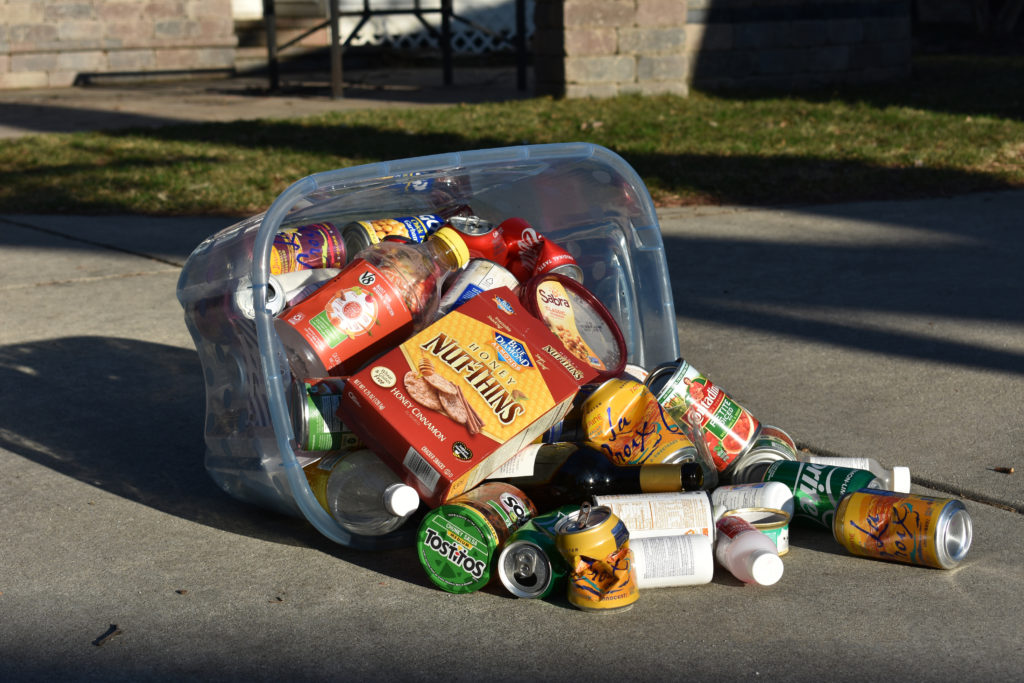Tosa Connection magazine
Recycling Easy Road Hits a Dead End

Most American consumers know that China manufactures many of the inexpensive plastic products that they purchase. What many of us didn’t realize, until recently, is that China was importing much of the source material for this manufacturing from the United States, some of it likely coming from recycling bins collected from Wauwatosa and other municipalities across the country.
For years the practice flew under the radar, and we are probably only talking about it now as a result of China pulling the plug in 2018. The impact has been felt by municipalities, small and large, including Wauwatosa. The city has gone from generating revenue from our recycled material to paying to get rid of it.
Cutting Out the Middle Man
In years past, the revenue from recycled materials would offset the processing fee for the City of Wauwatosa. The Wisconsin Department of Natural Resources reported that the composite value of a ton of recycling fell from an average of $80 per ton in 2017 to an average of $40 per ton in 2019. The impact in this dramatic decrease trickled all the way down the waste management stream to local municipalities like Wauwatosa.
Dave Simpson, Wauwatosa Director of Public Works, has been a front-line reformer of the Wauwatosa recycling process. With the net cost of recycling processing services jumping from $2,726.56 in 2017 to $134,228.92 in 2019, he knows that large modifications will be needed on his end even before city officials weigh some difficult decisions.
Advanced Disposal then transported the material to what is known as a MRF or Materials Recovery Facility. Here a private vendor, Republic Services, sourced the material, giving Wauwatosa a 70% cut on the sale.
After investigating, Simpson cut out the middleman, Advanced Disposal. Beginning in January 2020, Wauwatosa recycling trucks began delivering recycled material directly to the MRF where Republic Services both processes and sources the material. Streamlining this transaction is saving Wauwatosa money; however, it is also only one piece of the puzzle.
From Trash to Treasure
In 2017 a decades-long export market was about to yank its welcome mat. China had become the world’s import king, taking in about 45% of the world’s plastic waste, according to the Wisconsin DNR. In the early 1990s as it was growing into an emerging market, China discovered that imported waste could be used profitably.
Producing and exporting cheap plastic goods to high-income countries who in turn exported their waste right back to China worked for as long as it did, in part, because of lax environmental regulations. Because China would accept anything, exporters stopped worrying about contamination, or the mixing of unacceptable waste items with recyclable material. The U.S. exported approximately 4,000 containers a day, much of it worthless and never recycled. A 2015 study led by Scientist Jenna Jambeck at the University of Georgia estimated that 1.3 million to 3.5 million metric tons of contaminated plastic material were being dumped into the ocean from China’s shores annually.
The disruption of this manufacturing-recycling circle came with China’s announcement of its National Sword policy, effectively banning recycling imports. They officially closed their doors on January 1, 2018.
Some responded by diverting the material to other developing countries that would accept it, and initially countries including Indonesia, Malaysia, Thailand and Vietnam did. The Wisconsin DNR reports that these countries have implemented their own import restrictions. However, other reports indicate that the practice continues in some developing nations.
China’s open arms to imports led U.S. waste management companies to postpone developing their own recycling infrastructure. Now they are faced with a mountain of a problem that is growing bigger every day. A backlog of recycled material has developed as waste management companies scramble to find new markets.
Quality Vs. Quantity
Now that Simpson has found ways to cut costs with recycling, he is working on educating the public on how to recycle in a way that does not contaminate the recycling stream. Not only will this education be environmentally beneficial, it will help the city squeeze some more dollars out of our waste. Because Republic Services audits the material delivered to the MRF, the city is penalized for any contaminated product. Simpson believes education will help both those who do not recycle at all as well as the overzealous recyclers who participate in what he calls “wish-cycling,” believing that by throwing something in the bin, it can be recycled.
“Wish-cycling causes a lot of problems for downstream processing facilities and of course that affects the value of the commodity, and of course that affects all of us because as taxpayers we pay more to process,” Simpson said.
The biggest no-nos to drop in the recycling bin are plastic grocery bags and plastic film. Both clog the processing machinery leading to greater costs. Items referred to as “tanglers” in recycling lingo also cause processing nightmares. Tanglers include wire, Christmas lights and extension cords.
In coming weeks, Wauwatosa will be launching the Waste Wizard, an online tool, to help residents determine what should or shouldn’t be recycled. Not sure if wrapping paper should be recycled? Grab your phone and give it a quick check. Want to chuck a battery in the bin? Consult Waste Wizard on your iPad first.
Problem Solved, Right?
Not quite. Streamlining the recycling process and educating the public will definitely help. However, a gap between processing costs and recycling revenue still exists. In the first two months of 2020, Wauwatosa has spent approximately $37,500 on recycling processing fees, putting the city on pace to spend over $220,000 this year.
Some reports indicate that a number of U.S. communities have resorted to eliminating recycling services, dumping all waste in landfills.
Other communities have either added or increased recycling fees, an idea that Wauwatosa elected officials have opposed thus far. In the short term, officials will look at the first six months of 2020 data before they make any decisions on how they will make up for the shortfall in upcoming budgets. In the long term, Simpson says the answer is to reduce consumption.
“There’s no easy button. We’ve hit all of the easy buttons we can,” Simpson said. ‘If you don’t use it, you don’t have to throw it away, and we don’t have to recycle it because there are costs to both of those.”
A few examples that Simpson provided are ideas that most of us have probably heard before. They include utilizing reusable water bottles and grocery bags and using plates and utensils that can be washed and reused rather than paper, plastic and styrofoam.
Though many of us didn’t know it at the time, January 1, 2018 was a day of reckoning for consumers in the U.S. For big waste management companies, it was the time when they began developing local infrastructure to handle our own waste. For local residents, it may be the catalyst that forces us to start taking the concept of reducing consumption a little more seriously.
“If people can just start actively thinking: is there another way I can do this? That would add up to a big change,” Simpson said.
